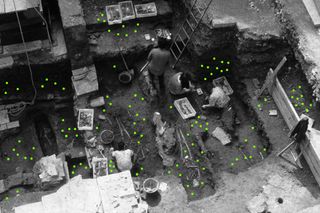
12,000‑Year‑Old Roman Burial Site Raises Concerns Of Rising Lead Pollution
Researchers note that the more lead we produce, the likelier it is to go straight into our bodies.

As one of the most abundantly used heavy metals, lead has had a complicated relationship with human history due to its effects on human health and the environment. A 12,000-year-old burial site in Italy confirmed just how fraught this relationship has been — researchers found that with every increase in the usage of lead, there was a corresponding increase in lead pollution that was found in the remains of 132 individuals at the site.
In a study published last week in Environmental Science and Technology, researchers confirmed that increased lead production in history is linked to corresponding increases in lead pollution in humans.
“This observation raises concerns that the forecasted increase in the production of lead and other metals might affect human health soon,” the paper stated.
“Simply put: the more lead we produce, the more people are likely to be absorbing it into their bodies. This has a highly toxic effect,” said Yigal Erels, a geologist from the Hebrew University of Jerusalem in Israel and lead author of the study, in a statement.
The study was able to determine the link by directly observing lead concentration in bones at the burial site to study how lead exposure in humans evolved since its discovery and widespread production approximately 5,000 years ago.
The calculation of lead concentration was done using the “lead to calcium ratio” — since lead is predominantly stored in the bones and teeth, and calcium is a key component of the same. Researchers also studied the presence of 20 other elements and found that there were no significant changes in Zinc, potassium, and others — showing that the rise in lead cannot be explained by natural biological processes.
With the production of coins roughly 2,500 years ago, lead production reached a peak during the Roman Empire. Previous studies of ice glaciers and lake sediment samples confirmed that its spread among local populations increased around this time. While the lead to calcium ratio in human remains was high at the time the Romans began using it, it was at the 2,500 year mark that this ratio saw a steep increase.
Furthermore, while previous research found a four-fold increase in lead production from the dawn of metallurgy to the height of the Roman Empire, the current study showed that the corresponding lead concentration found in human bones during this period increased 4,000 fold.
More concerningly, even those individuals who were not involved in local mining or smelting showed lead concentrations in their remains.
Indeed, the Romans used lead so much that some theories suggest that lead was behind the downfall of the ancient Roman empire.
Related on The Swaddle:
1 in 3 Children Globally Have Unhealthy Levels of Lead in Their System: UNICEF Report
Lead production subsequently fell during the Middle Ages. However, the pace picked up once again 1,000 years ago with the increase in silver mining, where lead was obtained as a by-product. It wasn’t until the last 250 years that lead began to be mined exclusively for its own use, researchers note — and the new study shows that these patterns of worldwide production are reflected in the analysis of bones from the site.
With these findings, researchers worry about a potential increase in lead dependence while switching to alternate energy sources, and the impact this would have on humans in vulnerable situations. Scientists estimate that to keep global temperature rise within 2 degree Celsius rather than 6 degrees by 2050, there would be a 1,200% increase in demand for lead, nickel, and cobalt for energy storage technologies
“This raises the concern that the current increasing use of several toxic metals (including Pb) in electronic devices and the transition to low-carbon energy production may soon be reflected in elevated concentrations of these metals in humans, predominantly in those that are not fortunate enough to live in regulated and monitored regions,” the study noted.
Researchers cited various other studies demonstrating the effects of lead pollution in people, especially children. The pathways for pollution include exposure sources as diverse as air, diet, and industrial lead. Moreover, poorer living and socio-economic conditions are factors in children’s concentrations of lead, which has adverse effects on their neurological development, learning, and behaviour.
According to the World Health Organization (WHO), lead poisoning affects nearly all organ systems and there is no level of exposure that is not accompanied by harmful health effects. It is also one of 10 chemicals identified by the WHO as a major public health concern.
Given these effects, researchers argue that the “increased use of metals should go hand in hand with augmented industrial hygiene, maximum metal recycling, and the consideration of environmental and toxicological aspects in the selection of metals for industrial use.”
Rohitha Naraharisetty is a Senior Associate Editor at The Swaddle. She writes about the intersection of gender, caste, social movements, and pop culture. She can be found on Instagram at @rohitha_97 or on Twitter at @romimacaronii.
Related


Urbanization Is Causing Mammals to Grow Bigger in Size, Shows Study
